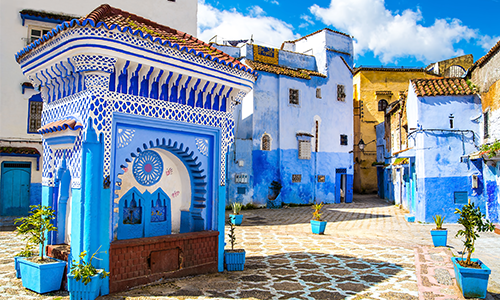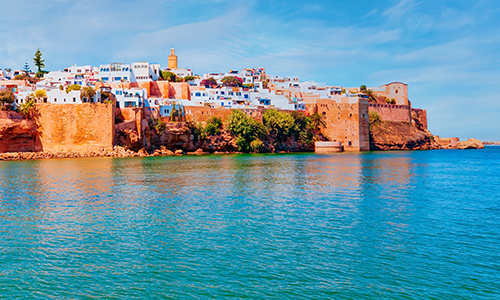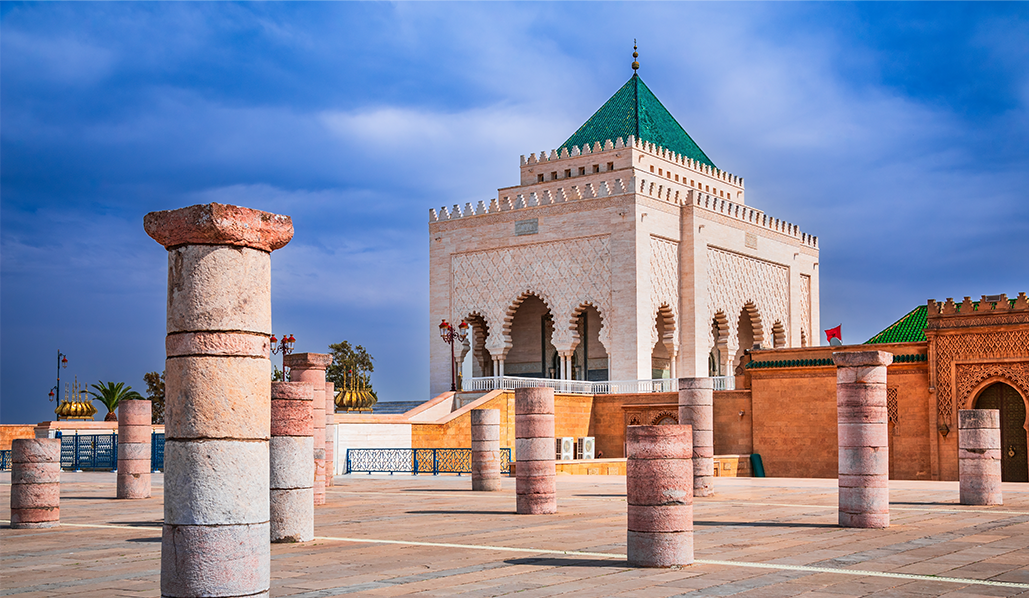Excursions
The NAFSA Global Summit includes a day of cultural immersion outside of Tangier. Attendees can choose between iconic Chefchaouen and legendary Rabat.
Day of Cultural Immersion - Chefchaouen
Chefchaouen also known as the Known as the “Blue Pearl,” is a picturesque mountain city in Morocco famed for its vivid blue-washed Medina, bustling Outa El Hammam Square, and the historic Kasbah museum.
The name "Chefchaouen" means "look at the horns" or "watch the horns," referring to the two mountain peaks above the town. It combines the Arabic word "Chef," meaning "to look," and the Berber word "Chaouen," meaning "horns," symbolizing the mountains that frame the city. This term highlights the town's location nestled between prominent, horn-shaped peaks in Morocco's Rif Mountains.
The Medina
Chefchaouen’s medina is an enchanting maze of narrow, winding streets where homes and shops are painted in distinctive shades of blue and white. The medina's gates and alleyways preserve much of their historic layout, with several old fountains and traditional structures scattered throughout. Artisan workshops line the alleys, offering local crafts, textiles, and pottery emblematic of Berber, Arab, and Andalusian influences.
Outa El Hammam Square
Outa El Hammam Square serves as the heart of the old town, surrounded by the major historic structures such as the Kasbah fortress and the Grand Mosque. The square is a lively meeting point filled with cafes, local eateries, shops, and the sound of everyday activity.
The Kasbah Museum
The Kasbah, built in 1471 by Rachid Ben Ali, is a fortified structure with bastions and towers positioned strategically on Outa El Hammam Square. Originally a governor’s residence, arsenal, and prison, it now houses an ethnographic museum that displays regional artifacts—traditional musical instruments, pottery, embroidered fabrics, weapons, and costumes representing the melting pot of Chefchaouen’s history. Its inner garden and rooftop terraces offer panoramic views of the city and surrounding Rif Mountains, while the museum hosts cultural exhibits and workshops year-round.
Chefchaouen’s blends tradition and modernity.
Day of Cultural Immersion - Rabat
Rabat, the capital city of Morocco, is a place rich in history and culture, boasting impressive landmarks such as the Royal Palace, Hassan Tower and Mausoleum of Mohammed V, and the Kasbah of the Udayas.
Royal Palace
The Royal Palace in Rabat serves as the official residence of the Moroccan royal family. While the palace itself is not open to the public, its grand exterior walls offer impressive views and symbolize the ongoing tradition of Morocco’s monarchy. The palace complex is surrounded by beautiful gardens and guarded entrances, playing a significant role in the city's identity.
Hassan Tower & Mausoleum of Mohammed V
The Hassan Tower is an iconic unfinished minaret built in the 12th century by Sultan Yacoub al-Mansour, originally intended to be the world's largest mosque. It stands 44 meters tall alongside rows of broken columns, a powerful visual reminder of the ambitious project halted by the Sultan's death. Adjacent to the tower is the Mausoleum of Mohammed V, a revered site housing the tombs of King Mohammed V and his sons. The mausoleum is celebrated for its exquisite Moroccan architecture, intricate tilework, gold leaf embellishments, and the accompanying mosque where non-Muslim visitors are allowed. The mausoleum symbolizes Morocco's royal heritage and independence.
Kasbah of the Udayas
The Kasbah of the Udayas is a 12th-century fortress at the mouth of the Bou Regreg River. It is a UNESCO World Heritage site featuring fortified walls, picturesque blue-and-white streets, and the serene Andalusian Gardens. Inside the kasbah lies the Oudayas Museum and several authentic eateries. Visitors enjoy strolling cobbled walkways, discovering the imposing Bab Oudaya gate, and taking in panoramic views of the Atlantic Ocean and Salé. The kasbah exemplifies Rabat’s blend of history, culture, and natural beauty.
Together, these landmarks encapsulate Rabat's regal history, architectural splendor, and cultural richness.
An excursion to Asilah from Tangier offers a delightful blend of history, art, and coastal charm in a serene, picturesque town on Morocco’s Atlantic coast.
Medina and Historic Walls
Asilah’s old medina is a beautifully preserved and peaceful pedestrian area, enclosed by 15th-century Portuguese ramparts. Visitors can wander through narrow alleys lined with whitewashed houses adorned with colorful murals and vibrant blue or green shutters, reflecting the town’s Moorish, Spanish, and Portuguese influences. The medina is also known for its lively souks and artisan shops selling ceramics, jewelry, spices, and rugs.
Krikia Viewpoint and Sunset
One of the highlights is the Krikia viewpoint, a natural amphitheater on the ramparts offering magnificent views over the Atlantic Ocean and the town’s fortified walls. It’s especially popular at sunset, where the scenic coastline and colorful town bathe in golden light, creating perfect photo opportunities and a peaceful atmosphere.
Historic Towers and Gates
Explorers can visit key landmarks such as the Alqamra Tower (also known as the Red Tower), a 16th-century Portuguese defense tower with panoramic views of the sea and medina rooftops. Nearby is Bab el Bahr, the “Gate of the Sea,” historically serving as the city’s gateway to the ocean and fishing docks. The Borj Al Kasbah, a prominent 15th-century tower, once protected the city from invasions and pirates and is surrounded by groves of palm trees.
Art and Culture
Asilah is renowned for its vibrant art scene, especially its annual Cultural Moussem Festival where artists paint murals across the medina walls. Even outside the festival season, visitors will find murals, public sculptures, and colorful street art that lend the town a distinctive artistic atmosphere.




